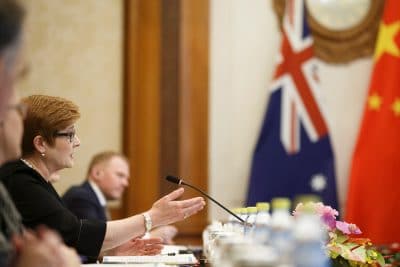China
Hitting reset on the Australia–China relationship

Author: Peter Van Ness, ANU
After years of disputes — over the origins of COVID-19, serious Chinese foreign trade restrictions, and differences about the fate of tennis star Peng Shuai — and working together with our Asian and Pacific neighbours, it is time for a new beginning in Australia’s relations with China. Recent events provide the opportunity, and there is evidence that Beijing may also be interested in a new beginning.
The Regional Comprehensive Economic Partnership (RCEP), the world’s largest free trade agreement, entered into force on 1 January 2022, linking China and Australia to eight other Asian neighbours, with several other countries soon to join. RCEP is designed to include 15 Asian countries, but neither the United States nor India has joined.
The agreement provides new multilateral opportunities for Australia to cooperate with its ASEAN neighbours and China, without the participation of the United States and other major powers. Australia should take the opportunity to raise the issue about Chinese punitive tariffs on Australian imports in this multilateral forum, while responding creatively to new opportunities for cooperation and collaboration.
About the same time, in response to violent riots in the Solomon Islands last November, Prime Minister Manasseh Sogavare asked China to send Chinese police liaison officers to help train and equip the Solomon Islands’ police force. Riots had erupted because of differences between Sogavare and the most populous province, Malaita, which arose after the government’s decision to switch its diplomatic relations from Taiwan to the People’s Republic of China back in 2019.
Earlier, Australia, New Zealand, Fiji and Papua New Guinea had sent some 200 soldiers and police to help, responding to the Prime Minister Sogavare’s request. Australia has a security pact with the Solomon Islands, and previously, from 2003 to 2017, deployed Australia Defence Force personnel to assist in maintaining order.
Based on its past experience of working with the police in Honiara, Australia might welcome the Chinese liaison officers and suggest ways to cooperate in their work for the Solomon Islands. Collaborating with both the Solomons and the Chinese in peacekeeping could become a new way to respond to China. Comments by Chinese diplomat Wang Xining, on 20 January, suggest that China might welcome such collaboration.
Both the new relationships with China on trade, and now, potentially in collaborating in peacekeeping in the Solomon Islands, could be a first step in trying to restore a working relationship with China in 2022.
But this is not a proposal to back off on Australia’s criticism of China.
Australia must continue to condemn the Chinese Communist Party’s treatment of the Uyghurs and other minorities in Xinjiang, Chinese territorial aggression in the South China Sea, and China’s betrayal of its 1997 commitment to Hong Kong. Australia should stand firm on its own values and remain willing to point out the worst practices of Xi Jinping’s authoritarian leadership.
Especially in response to its own rise in power, China is going to have to get used to criticism. Australia’s 2022 proposal to China might be something like: collaborate when we can and differ when we must — as we propose to work together to find new guidelines for cooperation and contestation.
Just now, every one of our neighbouring countries, either in Southeast Asia or the Pacific, are trying to work out how to deal with a more powerful and more intrusive China. This is a high priority for all. Working together multilaterally in RCEP, or bilaterally as with the Solomons, regional countries can support each other and learn from each other about how best to work with the China’s government.
In the past, Australian governments have built their national security strategies while depending on commitments from major world powers — mainly the United States. The ANZUS pact and the security relationship with the United States have been the foundation of those ties since the end of the Second World War.
Now, the AUKUS agreement with the United States and the United Kingdom to provide nuclear-powered submarines to Australia has reinforced that relationship. The Quadrilateral Security Dialogue, linking the United States, India, Japan and Australia, is another example. On 6 January 2022, the prime ministers of Australia and Japan signed an agreement to enhance military cooperation between the Australian Defence Force and the Japanese Self-Defense Forces.
These are commitments from major…
China
China’s November 2024 Economy: Navigating Mixed Signals and Ongoing Challenges

In November 2024, China’s economy exhibited mixed results: industrial production rose by 5.4%, while retail sales grew only 3%, below forecasts. Fixed asset investment also faltered. Policymakers are anticipated to introduce measures to stimulate domestic demand and combat deflation.
China’s economy showed mixed performance in November 2024, with industrial production and exports showing resilience, while retail sales and fixed asset investment underperformed, amid ongoing challenges in the property sector. Policymakers are expected to implement targeted fiscal and monetary measures to boost domestic demand and address deflationary pressures.
The National Bureau of Statistics (NBS) has released China’s economy data for November 2024, revealing a mixed performance across key indicators. Retail sales grew by 3 percent year-on-year, a significant slowdown from October’s 4.8 percent growth and well below the 4.6 percent forecast. Industrial production, however, showed resilience, rising by 5.4 percent and exceeding expectations of 5.3 percent growth.
The property sector continued to drag on the broader economy, with real estate investment contracting by 10.4 percent for the January-to-November period, further highlighting the challenges in stabilizing the sector. Fixed asset investment also fell short of expectations, growing by 3.3 percent year-to-date, down from 3.4 percent in October.
In November, China’s industrial value added (IVA) grew by 5.4 percent year-on-year (YoY), slightly accelerating from the 5.3 percent recorded in October. This modest improvement reflects continued recovery in key industries, supported by recent stimulus measures aimed at stabilizing the economy.
The manufacturing sector led the growth, expanding by 6.0 percent YoY, while the power, heat, gas, and water production and supply sector grew by 1.6 percent. The mining industry posted a 4.2 percent YoY increase. Notably, advanced industries outpaced overall growth, with equipment manufacturing and high-tech manufacturing rising by 7.6 percent and 7.8 percent YoY, respectively, underscoring the resilience of China’s innovation-driven sectors.
Key product categories showed robust output gains in November:
From January to November, IVA increased by 5.8 percent YoY, maintaining steady growth over the year despite headwinds from a slowing property market and external uncertainties.
| This article was first published by China Briefing , which is produced by Dezan Shira & Associates. The firm assists foreign investors throughout Asia from offices across the world, including in in China, Hong Kong, Vietnam, Singapore, and India . Readers may write to info@dezshira.com for more support. |
Read the rest of the original article.
China
Ukraine war: 10% of Chinese people are willing to boycott Russian goods over invasion – new study

Since Russia’s 2022 invasion of Ukraine, some Chinese citizens express dissent through potential boycotts of Russian goods, reflecting a complex relationship despite government support for Russia.
Since Russia invaded Ukraine in 2022, the Chinese government has been criticised for its refusal to condemn the war. In 2024, the economic and diplomatic relationship between the two nations appears stronger than ever.
Because of strict censorship and repression imposed by the Chinese Communist Party (CCP), it is difficult to know the extent to which the general public shares their government’s support of Putin’s regime. But a newly published study I carried out with colleagues found that more than 10% of Chinese people surveyed were willing to boycott Russian goods over the war in Ukraine.
This is a surprisingly large figure, especially since existing surveys indicate that Chinese people hold a broadly positive view of their neighbour. We used a representative sample of 3,029 Chinese citizens for this research, to dig into public attitudes to Russia. The survey was done in 2022 after the Ukraine invasion.
We were aware that due to widespread censorship, our participants might not be willing to give honest answers to questions about Russia’s actions in Ukraine. They might also not feel safe to do that in a regime where disagreement with the CCP’s position is often met with harsh punishment. This is why we asked them to tell us if they would be willing to boycott Russian products currently sold in China.
We felt this question was a good indicator of how much the participants disapproved of Russian foreign policy in Ukraine. More importantly, we were also curious to find out whether Chinese citizens would be willing to take direct political action to punish Russia economically for its aggressive behaviour.
In our study, we split respondents into the three different ideological groups in China: “liberals”, who support the free market and oppose authoritarianism; “the new left”, who sympathise with the policies pursued in China under Mao Zedong; and “neo-authoritarians”, who believe the Russian-Ukrainian conflict is an extension of the rivalry between authoritarian China and the liberal United States. These groups were based on the main political beliefs in China.
We found that liberals were most likely to say they were willing to boycott Russian products. Liberals believe that China should work with, rather than against, western democracies. They also place a high value on human rights and democratic freedoms. Because of their beliefs, they are likely to think that Russia’s actions against Ukraine were unprovoked, aggressive and disproportional.
Chinese and Russian economic and diplomatic relations seem closer than ever in 2024.
American Photo Archive/Alamy
The new left and neo-authoritarians we surveyed were more supportive of Russian products. The new left see Russia as a close ally and believe that Nato’s expansion in eastern Europe was a form of aggression. Neo-authoritarians, on the other hand, believe that supporting Russia, an allied autocracy, is in China’s best interest.
Boycotting Russian goods
Asking Chinese participants if they are willing to boycott Russian products might seem like a simple matter of consumer preferences. However, our study reveals a great deal about the way in which regular citizens can express controversial political beliefs in a repressive authoritarian regime.
Boycotting products of certain companies has long been studied in the west as a form of unconventional political action that helps people express their beliefs. However, in the west, boycotting certain products is simply one of many ways people are able to take political action. In a country such as China, boycotting a Russian product might often be the only safe way to express disagreement with the country’s actions.
This is because citizens do not have to tell others they chose not to buy a product, and their actions are unlikely to attract the attention of the authorities.
Since Russian goods are readily available to Chinese consumers and China is encouraging more Russian exports to reach its market, the Russian economy could be significantly affected by an organised boycott campaign in China. The considerable level of support for a boycott expressed by some of our participants, as well as previous acts of solidarity with Ukraine in China, suggest that such a campaign could already be taking place in the country.
This could harm Russia because it regularly exports a number of different products such as meat, chocolate, tea and wine to China. These goods made up 5.1% of China’s total imports in 2023 – and this figure is likely to increase if Russia becomes more isolated from the west, and therefore more dependent on China for its trade.
While 5.1% of the Chinese market might seem like a low figure, China is home to over 1.4 billion people. In this context, even a small boycott could result in a serious loss to Russian companies.
Our research shows that Chinese citizens don’t always support the official position of the communist party. It also shows that many people there will express even the most unpopular political opinions – if they can find a safe way to do it.
This article is republished from The Conversation under a Creative Commons license. Read the original article.
China
Australia Can Enhance China’s Credibility in the CPTPP
In early 2024, China sought to join the CPTPP, potentially offering modest economic benefits to Australia. Key reforms include limiting state-owned enterprise subsidies, enhancing data flows, and banning forced labor.
China’s Interest in the CPTPP
In early 2024, China expressed a keen interest in joining the Comprehensive and Progressive Agreement for Trans-Pacific Partnership (CPTPP), a trade agreement involving eleven Pacific Rim economies and the United Kingdom. This move is anticipated to yield modest economic benefits for Australia. However, it also opens the door for vital reforms in areas such as the control of subsidies for state-owned enterprises, allowing free cross-border data flows, and prohibiting forced labor practices.
Economic Implications for Australia
A May 2024 report from the Australian Productivity Commission indicated that China’s accession to the CPTPP might raise Australia’s GDP by only 0.01%. This modest gain isn’t surprising, given Australia’s existing preferential trade arrangement with China through the Regional Comprehensive Economic Partnership. Nonetheless, the CPTPP encompasses more than just tariff reductions, focusing on broader trade principles and standards.
Reform Commitments Required from China
For China to become a CPTPP member, it must demonstrate adherence to high-standard rules initially developed with the country in mind. This commitment will help alleviate concerns among member nations like Japan and Canada, particularly regarding China’s economic practices and geopolitical tensions, such as those with Taiwan. Membership would necessitate reforms, including limiting SOE subsidies, enabling freer data flows, and banning forced labor, with significant penalties for non-compliance.
Source : Australia can encourage China’s credibility in the CPTPP






